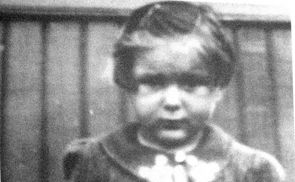Saturday 21 April 1945
Königs Wusterhausen: Death march to the north
"Königs Wusterhausen: Death march to the north "When the Russian troops approached Königs Wusterhausen in April 1945, we were all quickly transported to Sachsenhausen. There the image of Ravensbrück was repeated in almost the same cruelty, but the stay here did not last very long. After a short time - we could hear clearly the approaching front and see it glowing in the night as red glow in the sky - all prisoners were ordered to set off. That was the death march. The barracks, it was said, were loaded with explosives and were blown up. But my mother said she had no strength left to go, and that she didn't care where or how she died."
(report by Dr Richard Fagot)
Richard Fagot came from an assimilated Jewish family from Łódź. His father was director of one of the biggest rubber factories in Poland. On Fagot's fourth birthday the Wehrmacht invades the country. A little later he has to move with his family to the newly built "Ghetto Litzmannstadt". However, Fagot's family is very lucky to escape deportation to Auschwitz. Together with a few other families, they are selected to produce makeshift homes for bombed-out German families in Königs Wusterhausen. After a stopover in the concentration camp of Sachsenhausen, the family is separated. The father is transferred to Königs Wusterhausen. Fagot and his mother are sent, like the other women, to the Ravensbrück concentration camp, where they survive the winter under catastrophic conditions. In February 1945 the surviving Łódźer women and about 30 children are "surprisingly brought out of hell" and brought to Königs Wusterhausen.
Background:
The Königs Wusterhausen concentration camp subcamp, located southeast of the Berlin city limits, was built in 1944 and was located at the goods station, in the eastern part of Königs Wusterhausen (Storkower Straße/Priestergraben). Most of the approximately 600 Jewish prisoners of the camp came from Łódź. When the Łódźer ghetto was closed down, they were held back by the SS for clean-up work and then transferred to Königs Wusterhausen.
The women in the camp had to nail together ammunition boxes for the Krupp company and produce "winter construction boxes" for truck engines from Siemens. The men were employed in the nearby production of makeshift homes.
A few days before the liberation of the camp on April 26, 1945, some of the male prisoners were taken to Sachsenhausen and from there sent on the death march towards Mecklenburg. Among them was Dr. Richard Fagot. Weakened by the exertions, many of the prisoners were shot on the march. A second group, consisting of children and women, had to start the march from the concentration camp subcamp Königs Wusterhausen towards Sachsenhausen between April 18 and 20, 1945. Some of them were liberated by Soviet troops on the way to Sachsenhausen. The guards of the camp fled on April 22 in civilian clothing. The Red Army reached the camp on April 26, 1945.

![[Translate to englisch:] Prisoner columns in front of the camp gate to the Sachsenhausen concentration camp](https://www.zwangslager-berlin-1945.de/fileadmin/_processed_/6/4/csm_Lagertor_Sachsenhausen_434a8ce3bd.jpg)